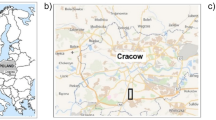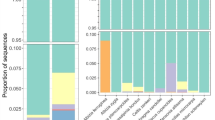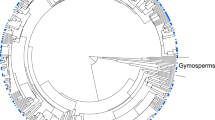Abstract
Understanding the impacts of co-invasion of multiple invaders on soil bacterial communities is significant in understanding the mechanisms driving successful invasion. This study aimed to determine the response of soil bacterial communities to co-invasion of two invaders daisy fleabane (Erigeron annuus) and Canada goldenrod (Solidago canadensis). Daisy fleabane and/or Canada goldenrod invasion significantly enhanced the operational taxonomic unit richness, Shannon index, and Chao1 index of soil bacterial communities. Canada goldenrod under light degree of invasion and co-invasion of daisy fleabane and Canada goldenrod regardless of invasion degree signally improved the ACE index of soil bacterial communities. Thus, the two invaders can enhance soil bacterial diversity and richness to facilitating subsequent invasion due to the fact that higher soil bacterial diversity and richness can enhance the levels of soil function and nutrients acquisition of plant species. ACE index of soil bacterial communities subjected to co-invasion of daisy fleabane and Canada goldenrod regardless of invasion degree was greater than that under the independent invasion of either daisy fleabane or Canada goldenrod. Hence, co-invasion of the two invaders can impose synergistic impacts on soil bacterial richness, which may build a preferable soil micro-environment via the intensified soil bacterial communities, which is contributive to their following invasion.
摘要
一些入侵植物成功入侵的主因之一就是它们促进其根际土壤微生物群落的演替. 此外, 同一生态系统中可能遭受两种甚至是两种以上入侵植物的入侵. 所以, 探究共同入侵的入侵植物对土壤细菌群落的影响对阐明入侵植物成功入侵的机理具有重要作用. 本文以高通量测序技术为手段, 探究不同入侵程度的一年蓬和加拿大一枝黄花共同入侵对土壤细菌群落结构的影响. 一年蓬和/或加拿大一枝黄花入侵显著增加了土壤细菌的、 Shannon 指数和 Chao1 指数. 低度入侵的加拿大一枝黄花以及一年蓬 和加拿大一枝黄花共同入侵显著增加了土壤细菌的 ACE 指数. 一年蓬和/或加拿大一枝黄花可通过增加土壤细菌群落的多样性和丰度促进了其进一步的入侵进程, 高的土壤细菌群落多样性和丰度可提升土壤功能和营养获取水平. 与一年蓬和加拿大一枝黄花单一入侵相比, 一年蓬和加拿大一枝黄花共同入侵显著增加了土壤细菌的 ACE 指数. 因此, 一年蓬和加拿大一枝黄花共同入侵对影响土壤细菌群落丰度具有协同作用, 构建了一个利于其自身生长及其进一步入侵的土壤微环境条件.
Similar content being viewed by others
References
KUEBBING S E, CLASSEN A T, SIMBERLOFF D. Two co-occurring invasive woody shrubs alter soil properties and promote subdominant invasive species [J]. Journal of Applied Ecology, 2014, 51(1): 124–133. DOI: https://doi.org/10.1111/1365-2664.12161.
KUEBBING S E, PATTERSON C M, CLASSEN A T, SIMBERLOFF D. Co-occurring nonnative woody shrubs have additive and non-additive soil legacies [J]. Ecological Applications, 2016, 26(6): 1896–1906. DOI: https://doi.org/10.1890/15-1931.1.
WANG C Y, JIANG K, LIU J, ZHOU J W, WU B D. Moderate and heavy Solidago canadensis L. invasion are associated with decreased taxonomic diversity but increased functional diversity of plant communities in East China [J]. Ecological Engineering, 2018, 112(3): 55–64. DOI: https://doi.org/10.1016/j.ecoleng.2017.12.025.
WANG C Y, LIU J, ZHOU J W, XIAO H G. Differences in leaf functional traits between exotic and native compositae plant species [J]. Journal of Central South University, 2017, 24(10): 2468–2474. DOI: https://doi.org/10.1007/s11771-017-3658-7.
WANG C Y, ZHOU J W, LIU J, XIAO H G, WANG L. Differences in functional traits and reproductive allocations between native and invasive plants [J]. Journal of Central South University, 2018, 25(3): 516–525. DOI: https://doi.org/10.1007/s11771-018-3756-1.
SOUZA-ALONSO P, GUISANDE-COLLAZO A, GONZÁLEZ L. Gradualism in Acacia dealbata Link invasion: Impact on soil chemistry and microbial community over a chronological sequence [J]. Soil Biology and Biochemistry, 2015, 80: 315–323. DOI: https://doi.org/10.1016/j.soilbio.2014.10.022.
PIPER C L, SICILIANO S D, WINSLEY T, LAMB E G. Smooth brome invasion increases rare soil bacterial species prevalence, bacterial species richness and evenness [J]. Journal of Ecology, 2015, 103(2): 386–396. DOI: https://doi.org/10.1111/1365-2745.12356.
WANG C Y, JIANG K, ZHOU J W, WU B D. Solidago canadensis invasion affects soil N-fixing bacterial communities in heterogeneous landscapes in urban ecosystems in East China [J]. Science of the Total Environment, 2018, 631–632: 702–713. DOI: https://doi.org/10.1016/j.scitotenv.2018.03.061.
WANG C Y, ZHOU J W, LIU J, DU D L. Responses of soil N-fixing bacteria communities to invasive species over a gradient of simulated nitrogen deposition [J]. Ecological Engineering, 2017, 98(1): 32–39. DOI: https://doi.org/10.1016/j.ecoleng.2016.10.073.
WANG C Y, ZHOU J W, LIU J, JIANG K, DU D L. Responses of soil N-fixing bacteria communities to Amaranthus retroflexus invasion under different forms of N deposition [J]. Agriculture, Ecosystems & Environment, 2017, 247: 329–336. DOI: https://doi.org/10.15244/pjoes/64240.
WANG C Y, WEI M, WANG S, WU B D, DU D L. Cadmium influences the litter decomposition of Solidago canadensis L. and soil N-fixing bacterial communities [J]. Chemosphere, 2020, 246: 125717. DOI: https://doi.org/10.1016/j.chemosphere.2019.125717.
WANG C Y, JIANG K, ZHOU J W, XIAO H G, WANG L. Responses of soil bacterial communities to Conyza canadensis invasion with different cover classes along a climatic gradient [J]. Clean-Soil, Air, Water, 2018, 46(8): 1800212. DOI: https://doi.org/10.1002/clen.201800212.
THEOHARIDES K A, DUKES J S. Plant invasion across space and time, factors affecting nonindigenous species success during four stages of invasion [J]. New Phytologist, 2007, 176(2): 256–273. DOI: https://doi.org/10.1111/J.1469-8137.2007.02207.x.
RAI P K. Paradigm of plant invasion: multifaceted review on sustainable management [J]. Environmental Monitoring and Assessment, 2015, 187(12): 759. DOI: https://doi.org/10.1007/s10661-015-4934-3.
WANG C Y, ZHOU J W, LIU J, JIANG K, XIAO H G, DU D L. Responses of the soil fungal communities to the co-invasion of two invasive species with different cover classes [J]. Plant Biology, 2018, 20(1): 151–159. DOI: https://doi.org/10.1111/plb.12646.
WANG C Y, ZHOU J W, LIU J, WANG L, XIAO H G. Reproductive allocation strategy of two herbaceous invasive plants across different cover classes [J]. Polish Journal of Environmental Studies, 2017, 26(1): 355–364. DOI: https://doi.org/10.15244/pjoes/64240.
WANG C Y, WEI M, WANG S, WU B D, CHENG H Y. Erigeron annuus (L.) Pers. and Solidago canadensis L. antagonistically affect community stability and community invasibility under the co-invasion condition [J]. Science of the Total Environment, 2020, 716: 137128. DOI: https://doi.org/10.1016/j.scitotenv.2020.137128.
WANG C Y, ZHOU J W, LIU J, XIAO H G, WANG L. Functional traits and reproductive allocation strategy of Conyza canadensis as they vary by invasion degree along a latitude gradient [J]. Polish Journal of Environmental Studies, 2017, 26(3): 1289–1297. DOI: https://doi.org/10.15244/pjoes/66175.
LORENZO P, PEREIRA C S, RODRÍGUEZ-ECHEVERRÍA S. Differential impact on soil microbes of allelopathic compounds released by the invasive Acacia dealbata link [J]. Soil Biology and Biochemistry, 2013, 57(3): 156–163. DOI: https://doi.org/10.1016/j.soilbio.2012.08.018.
FAN L, CHEN Y, YUAN J G, YANG Z Y. The effect of Lantana camara Linn. invasion on soil chemical and microbiological properties and plant biomass accumulation in southern China [J]. Geoderma, 2010, 154(3, 4): 370–378. DOI: https://doi.org/10.1016/j.geoderma.2009.11.010.
LORENZO P, RODRLGUEZ-ECHEVERRLA S, GONZÁLEZ L, FREITAS H. Effect of invasive Acacia dealbata Link on soil microorganisms as determined by PCR-DGGE [J]. Applied Soil Ecology, 2010, 44(3): 245–251. DOI: https://doi.org/10.1016/j.apsoil.2010.01.001.
YAN X L, LIU Q R, SHOU H Y, ZENG X F, ZHANG Y, CHEN L, LIU Y, MA H Y, QI S Y, MA J S. The categorization and analysis on the geographic distribution patterns of Chinese alien invasive plants [J]. Biodiversity Science, 2014, 22(5): 667–676. DOI: https://doi.org/10.3724/SP.J.1003.2014.14069. (in Chinese)
WANG C Y, LIU J, XIAO H G, ZHOU J W, DU D L. Floristic characteristics of alien invasive seed plant species in China [J]. Anais da Academia Brasileira de Ciencias, 2016, 88(3): 1791–1797. DOI: https://doi.org/10.1590/0001-3765201620150687.
WEBER E, GUO S G, LI B. Invasive alien plants in China: diversity and ecological insights [J]. Biological Invasions, 2008, 10(8): 1411–1429. DOI: https://doi.org/10.1007/s10530-008-9216-3.
ZHAO S Y, SUN S G, DAI C, GITURU R W, CHEN J M, WANG Q F. Genetic variation and structure in native and invasive Solidago canadensis populations [J]. Weed Research, 2015, 55(2): 163–172. DOI: https://doi.org/10.1111/wre.12130.
DUDA J J, FREEMAN D C, EMLEN J M, BELNAP J, KITCHEN S G, ZAK J C, SOBEK E, TRACY M, MONTANTE J. Differences in native soil ecology associated with invasion of the exotic annual chenopod, Halogeton glomeratus [J]. Biology and Fertility of Soils, 2003, 38(2): 72–77. DOI: https://doi.org/10.1007/s00374-003-0638-x.
SVENSSON J R, NYLUND G M, CERVIN G, TOTH G B, PAVIA H. Novel chemical weapon of an exotic macroalga inhibits recruitment of native competitors in the invaded range [J]. Journal of Ecology, 2013, 101(1): 140–148. DOI: https://doi.org/10.1111/1365-2745.12028.
HANG Z H, WU H P. Zhenjiang yearbook: Overview of Zhenjiang (The first edition) [M]. Beijing: Publishing House of Local Records, 2017: 30–31. (in Chinese)
WU B D, ZHANG H S, JIANG K, ZHOU J W, WANG C Y. Erigeron canadensis affects the taxonomic and functional diversity of plant communities in two climate zones in the North of China [J]. Ecological Research, 2019, 34(4): 535–547. DOI: https://doi.org/10.1111/1440-1703.12024.
LEI N F, LI J, NI S J, CHEN J S. Effects of clonal integration on microbial community composition and processes in the rhizosphere of the stoloniferous herb Glechoma longituba (Nakai) Kuprian [J]. PLoS One, 2014, 9(9): e108259. DOI: https://doi.org/10.1371/journal.pone.0108259.
ZHANG W L, XU A G, ZHANG R L, JI H J. Review of soil classification and revision of China soil classification system [J]. Scientia Agricultura Sinica, 2014, 47(16): 3214–3230. DOI: https://doi.org/10.3864/j.issn.0578-1752.2014.16.009. (in Chinese)
IUSS Working Group WRB. World reference base for soil resources. International soil classification system for naming soils and creating legends for soil maps [M]. World Soil Resources Reports, 2015.
HERLEMANN DPR, LABRENZ M, JÜRGENS K, BERTILSSON S, WANIEK J J, ANDERSSON A F. Transitions in bacterial communities along the 2000 km salinity gradient of the Baltic Sea [J]. ISME Journal, 2011, 5: 1571–1579. DOI: https://doi.org/10.1038/ismej.2011.41.
HUGERTH L W, WEFER H A, LUNDIN S, JAKOBSSON H E, LINDBERG M, RODIN S, ENGSTRANDB L, ANDERSSONA A F. DegePrime, a program for degenerate primer design for broad-taxonomic-range PCR in microbial ecology studies [J]. Applied and Environmental Microbiology, 2014, 80: 5116–5123. DOI: https://doi.org/10.1128/AEM.01403-14.
KUEBBING S E, SOUZA L, SANDERS N J. Effects of co-occurring non-native invasive plant species on old-field succession [J]. Forest Ecology and Management, 2014, 324: 196–204. DOI: https://doi.org/10.1016/j.foreco.2013.10.031.
SHEN W S, GAO N, MIN J, SHI W M, HE X H, LIN X G. Influences of past application rates of nitrogen and a catch crop on soil microbial communities between an intensive rotation [J]. Acta Agriculturae Scandinavica, 2016, 66(2): 97–106. DOI: https://doi.org/10.1080/09064710.2015.1072234.
FIERER N, JACKSON R B. The diversity and biogeography of soil bacterial communities [J]. Proceedings of the National Academy of Sciences of the United States of America, 2006, 103(3): 626–631. DOI: https://doi.org/10.1073/pnas.0507535103.
WU X, WU H, YE J Y, ZHONG B. Study on the release routes of allelochemicals from Pistia stratiotes Linn., and its anti-cyanobacteria mechanisms on Microcystis aeruginosa [J]. Environmental Science and Pollution Research, 2015, 22: 18994–19001. DOI: https://doi.org/10.1007/s11356-015-5104-4.
KULMATISKI A, BEARD K H, STEVENS J R, COBBOLD S M. Plant-soil feedbacks: A meta-analytical review [J]. Ecology Letters, 2008, 11(9): 980–992. DOI: https://doi.org/10.1111/j.1461-0248.2008.01209.x.
LINDSAY E A, COLLOFF M J, GIBB N L, WAKELIN S A. The abundance of microbial functional genes in grassy woodlands is influenced more by soil nutrient enrichment than by recent weed invasion or livestock exclusion [J]. Applied and Environmental Microbiology, 2010, 76(16): 5547–5555. DOI: https://doi.org/10.1128/AEM.03054-09.
WAKELIN S A, GREGG A L, SIMPSON R J, LI G D, RILEY I T, MCKAY A C. Pasture management clearly affects soil microbial community structure and N-cycling bacteria [J]. Pedobiologia, 2009, 52(4): 237–251. DOI: https://doi.org/10.1016/j.pedobi.2008.10.001.
BELNAP J, PHILLIPS S L. Soil biota in an ungrazed grassland: response to annual grass (Bromus tectorum) invasion [J]. Ecological Applicationsl, 2001, 11(5): 1261–1275. DOI: https://doi.org/10.1890/1051-0761(2001)011[1261:SBIAUG]2.0.CO;2.
WANG C Y, XIANG J G, DU D L. The ecological effects of two invasive plants on soil microorganism community in rhizosphere [J]. Ecology and Environmental Sciences, 2012, 21(7): 1247–1251. DOI: https://doi.org/10.16258/j.cnki.1674-5906.2012.07.022. (in Chinese)
BARANTAL S, ROY J, FROMIN N, SCHIMANN H, HÄTTENSCHWILER S. Long-term presence of tree species but not chemical diversity affect litter mixture effects on decomposition in a neotropical rainforest [J]. Oecologia, 2011, 167(1): 241–252. DOI: https://doi.org/10.1007/s00442-011-1966-4.
CHAPMAN S K, NEWMAN G S, HART S C, SCHWEITZER J A, KOCH G W. Leaf litter mixtures alter microbial community development: mechanisms for non-additive effects in litter decomposition [J]. PLoS One, 2013, 8(4): e62671. DOI: https://doi.org/10.1371/journal.pone.0062671.
RODRIGUEZ-LOINAZ G, ONAINDIA M, AMEZAGA I, MIJANGOS I, GARBISU C. Relationship between vegetation diversity and soil functional diversity in native mixed-oak forests [J]. Soil Biology & Biochemistry, 2008, 40(1): 49–60. DOI: https://doi.org/10.1016/j.soilbio.2007.04.015.
EISENHAUER N, BEßLER H, ENGELS C, GLEIXNER G, HABEKOST M, MILCU A, PARTSCH S, SABAIS A C W, SCHERBER C, STEINBEISS S, WEIGELT A, WEISSER W W, SCHEU S. Plant diversity effects on soil microorganisms support the singular hypothesis [J]. Ecology, 2010, 91(2): 485–496. DOI: https://doi.org/10.1890/08-2338.1.
Author information
Authors and Affiliations
Corresponding author
Additional information
Foundation item: Project(31300343) supported by the National Natural Science Foundation of China; Project(PCRRF19009) supported by Open Science Research Fund of State Key Laboratory of Pollution Control and Resource Reuse (Tongji University), China; Project supported by Jiangsu Collaborative Innovation Center of Technology and Material of Water Treatment, China
Rights and permissions
About this article
Cite this article
Wei, M., Wang, S., Xiao, Hg. et al. Co-invasion of daisy fleabane and Canada goldenrod pose synergistic impacts on soil bacterial richness. J. Cent. South Univ. 27, 1790–1801 (2020). https://doi.org/10.1007/s11771-020-4408-9
Received:
Accepted:
Published:
Issue Date:
DOI: https://doi.org/10.1007/s11771-020-4408-9




